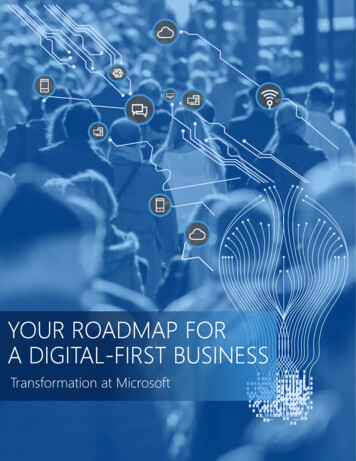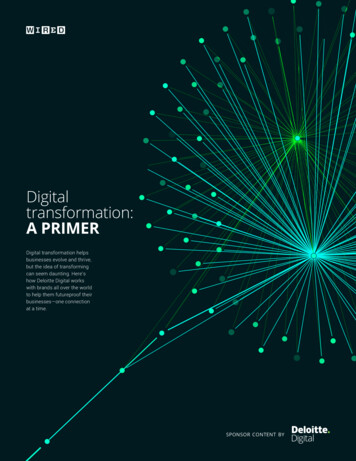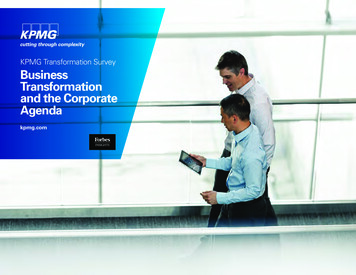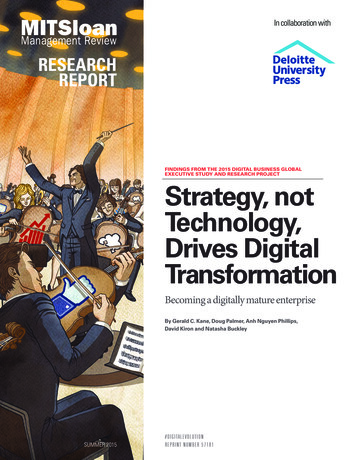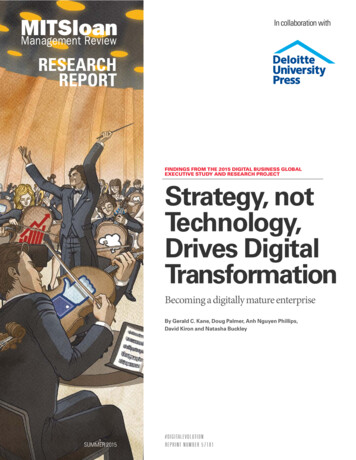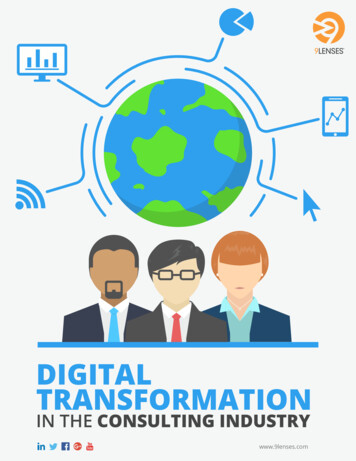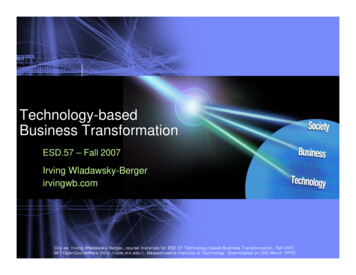
Transcription
Technology-basedBusiness TransformationESD.57 – Fall 2007Irving Wladawsky-Bergerirvingwb.comCite as: Irving Wladawsky-Berger, course materials for ESD.57 Technology-based Business Transformation, Fall 2007.MIT OpenCourseWare (http://ocw.mit.edu/), Massachusetts Institute of Technology. Downloaded on [DD Month YYYY].
Class Project- Clearly articulate the overall vision. What is the essence of the disruptive innovation? How willproject change the landscape in its industry over time?- Spend bulk of the time working out overall implementation of first phase(s) of the project,including development, sales channels, and marketing plan.- Convince us that you both have a compelling strategy and that you have the ability to executeyour first phase in a timely manner.- Write short paper – no more than five pages, - summarizing overall strategy and executionplan. e-mail paper to me and Sung Joo Bae by Tuesday, November 27.- Final class presentation and discussion – 30 minutes each – onNovember 29 and December 6. We will pick presentation order at random in next class.By October 18 – Submit 1 -2 page Analysis Creativity Design Development Holistic thinking .2Cite as: Irving Wladawsky-Berger, course materials for ESD.57 Technology-based Business Transformation, Fall 2007.MIT OpenCourseWare (http://ocw.mit.edu/), Massachusetts Institute of Technology. Downloaded on [DD Month YYYY].
Final Class Project Presentations – November 29 1 Bharat Bhushan, Rakesh Sahu – Renewable Petroleum 2 Kenfield Griffith – Disruptive Technologies in Architecture 3 Geoff Ashworth, Satwik Seshasai – Web 2.0 Innovation for EnergyIndustry 4 Ratandeep Bhattacharjee, Praveen Mathur, Christian Stanton – IPTVTechnologies 5 Timothy Aykroyd, Melvin Chiang, David Kim – On Demand ColorImages and Photos 6 Ankur Sinha – Health Care Industry Transformation3Cite as: Irving Wladawsky-Berger, course materials for ESD.57 Technology-based Business Transformation, Fall 2007.MIT OpenCourseWare (http://ocw.mit.edu/), Massachusetts Institute of Technology. Downloaded on [DD Month YYYY].
Final Class Project Presentations – December 6 7 Asad Rehan – IMS based Transformation of Telecom Industry 8 Ragu, Bharadwaj, Garrett Dodge, Michael Johnston – RFID basedDisruptive Innovation 9 James Xiao – Mobile Cardiac Outpatient Telemetry 10 John Baker, Arthur Mark – Disruptive Data Mining 11 Neelesh Pai – US Entry of Low Cost Tata Car4Cite as: Irving Wladawsky-Berger, course materials for ESD.57 Technology-based Business Transformation, Fall 2007.MIT OpenCourseWare (http://ocw.mit.edu/), Massachusetts Institute of Technology. Downloaded on [DD Month YYYY].
Class Overview Technology-based innovation and business survival Formulating a market strategy around a new,disruptive, complex technology Executing a multi-faceted strategy in the marketplace Organizational and cultural Issues Class project presentation and discussion5Cite as: Irving Wladawsky-Berger, course materials for ESD.57 Technology-based Business Transformation, Fall 2007.MIT OpenCourseWare (http://ocw.mit.edu/), Massachusetts Institute of Technology. Downloaded on [DD Month YYYY].
IBM’s e-business Strategy: Organizational and Cultural Issues Build a company-wide virtual organization¾For transformative, company-wide initiatives, it is best to havea relatively small full time core team coordinating activitiesacross the different functions in the organization¾After the initiative has taken hold in the company, the virtualteam should dissipate and its functions integrated back intothe overall organization Be inclusive of as much of organization as possible¾Other parts of the organization will likely not support the newdisruptive initiatives at first, especially if they are not involvedand feel excluded¾The more everybody feels part of the new initiative, the morethey will support it and help it succeed6Cite as: Irving Wladawsky-Berger, course materials for ESD.57 Technology-based Business Transformation, Fall 2007.MIT OpenCourseWare (http://ocw.mit.edu/), Massachusetts Institute of Technology. Downloaded on [DD Month YYYY].
IBM’s e-business Strategy: Organizational and Cultural Issues Sell the strategy “outside-in”¾ People will believe what they read in newspaper , magazine articlesand other external sources more than internal communications¾Make sure external marketing and communication activities receivewide internal visibility Internal communications and education¾ Don’t underestimate the need to explain new initiatives,educate people on what it is all about, their role in it - overand over and over Nurture core supporters¾Leverage the passion and commitment of strong core supportersand “evangelists” in convincing others about the value of strategy¾Often, strongest supporters will be those with strongest externalconnections – technical community, research, . . .7Cite as: Irving Wladawsky-Berger, course materials for ESD.57 Technology-based Business Transformation, Fall 2007.MIT OpenCourseWare (http://ocw.mit.edu/), Massachusetts Institute of Technology. Downloaded on [DD Month YYYY].
Role of senior executives in leading new growth How should senior executives allocate their time andenergy across all of the businesses and initiatives thatdemand their attention? How should their oversight of sustaining innovationsdiffer from their mode of management in disruptivesituations? Is the creation of new growth businesses inherently anidiosyncratic, ad hoc undertaking, or might it be possibleto create a repeatable process that successfullygenerates wave after wave of disruptive growth?The Innovator’s Solutions– Clay Christensen and Michael Raynor8Cite as: Irving Wladawsky-Berger, course materials for ESD.57 Technology-based Business Transformation, Fall 2007.MIT OpenCourseWare (http://ocw.mit.edu/), Massachusetts Institute of Technology. Downloaded on [DD Month YYYY].
Organizational capabilities for disruptive innovationText removed due to copyright restrictions.Quote from book below, stating that many innovations fail becausethe managerial strategies in place during stable times are notappropriate for handling disruptive change, and can often stifle these ideas.Meeting the Challenge of Disruptive Change– Clay Christensen and Michael Raynor9Cite as: Irving Wladawsky-Berger, course materials for ESD.57 Technology-based Business Transformation, Fall 2007.MIT OpenCourseWare (http://ocw.mit.edu/), Massachusetts Institute of Technology. Downloaded on [DD Month YYYY].
Role of senior executives in managing innovation Actively coordinate action and decisions when noprocesses exist to do the coordination Break the grip of established processes when a team isconfronted with new tasks that require new patters ofcommunication, coordination and decision making Create processes to reliably guide and coordinate andcoordinate the work of employees when recurrentactivities and decisions emerge in the organization Stand astride the whole organization to ensure thatuseful learning from the new growth businesses flowsback into the mainstream, and to ensure that the rightresources, processes and values are applied as neededThe Innovator’s Solutions– Clay Christensen and Michael Raynor10Cite as: Irving Wladawsky-Berger, course materials for ESD.57 Technology-based Business Transformation, Fall 2007.MIT OpenCourseWare (http://ocw.mit.edu/), Massachusetts Institute of Technology. Downloaded on [DD Month YYYY].
Creating a growth engine for disruptive innovations Start before you need¾Best time to invest is when company is still growing¾Pressure to get big fast forces ventures to do many things wrong Appoint a senior executive to oversee disruptive innovations¾Monitor the resource allocation process¾Decide which corporate processes do and do not apply¾Keep communications flowing across disruptive-sustaining boundary Create a team and processes for shaping new ideas¾Responsible for shaping ideas to fit the litmus tests of disruption¾Ensure that each action is appropriate to the circumstance Train the troops to identify disruptive ideas¾Engineers, marketing and sales people closest to the market need toknow what to look for¾Learn to identify which new ideas should be treated as potentiallydisruptive, which are potentially sustaining, and which are neither11Cite as: Irving Wladawsky-Berger, course materials for ESD.57 Technology-based Business Transformation, Fall 2007.MIT OpenCourseWare (http://ocw.mit.edu/), Massachusetts Institute of Technology. Downloaded on [DD Month YYYY].
CultureText removed due to copyright restrictions.Quote from book below, positing that the culture of an enterprise,in any field, is what determines whether it will fail or succeed.An enterprise must not only make use of things likevision, strategy, and so forth, but must embody them in its culture.Who Says Elephants Can’t Dance? - Lou Gerstner12Cite as: Irving Wladawsky-Berger, course materials for ESD.57 Technology-based Business Transformation, Fall 2007.MIT OpenCourseWare (http://ocw.mit.edu/), Massachusetts Institute of Technology. Downloaded on [DD Month YYYY].
Culture Most companies say their cultures are about the samethings – outstanding customer service, excellent,teamwork, shareholder value, responsible corporatebehavior and integrity. Most of the really important rules [of culture] are notwritten down anywhere. Successful institution almost always develop strongcultures that reinforce those elements that make theinstitution great. When that environment shifts, it is very hard for theculture to change. In fact, it becomes an enormousimpediment to the institution’s ability to adapt.13Cite as: Irving Wladawsky-Berger, course materials for ESD.57 Technology-based Business Transformation, Fall 2007.MIT OpenCourseWare (http://ocw.mit.edu/), Massachusetts Institute of Technology. Downloaded on [DD Month YYYY].
CultureText removed due to copyright restrictions.Quote from book below, stating that as a manager, one can't changethe attitudes and culture of a company's workers just by telling themto do so; one must provide incentives, redefine goals and "marketplacerealities," and then trust that the culture will change itself accordingly.Who Says Elephants Can’t Dance? - Lou Gerstner14Cite as: Irving Wladawsky-Berger, course materials for ESD.57 Technology-based Business Transformation, Fall 2007.MIT OpenCourseWare (http://ocw.mit.edu/), Massachusetts Institute of Technology. Downloaded on [DD Month YYYY].
Required Behavioral ChangeFrom15ToProduct out (I tell you)Customer in (in the shoes of the customerDo it my wayDo it the customer’s way: provide real serviceManage to moraleManage to successDecisions based on anecdotes and mythsDecisions based on facts and dataRelationship drivenPerformance-drive and measuredConformity - politically correctDiversity of ideas and opinionsAttack the peopleAttack the process - ask why not whoLooking good vs doing goodAccountabilityUS (Armonk) dominanceGlobal sharingRule-drivenPrinciple-drivenValue me (the silo)Value us (the whole)Analysis paralysis (100 %)Make decisions, move forward – 80/20 ruleNot Invented hereLearning organizationFund everythingPrioritizeCite as: Irving Wladawsky-Berger, course materials for ESD.57 Technology-based Business Transformation, Fall 2007.MIT OpenCourseWare (http://ocw.mit.edu/), Massachusetts Institute of Technology. Downloaded on [DD Month YYYY].
Transforming the Organization: Leadership Competencies Win: It was vital to understand that business is acompetitive activity. There are winners and losers. Weneeded to make the marketplace the driving criterion for allof our actions and all of our behavior. Execution: This was all about speed and discipline. Nomore studying things to death. In the new IBM, successfulpeople would commit to getting thins done – fast andeffectively. Team: This was a commitment to acting as one IBM, plainand simple.Who Says Elephants Can’t Dance – Lou Gerstner16Cite as: Irving Wladawsky-Berger, course materials for ESD.57 Technology-based Business Transformation, Fall 2007.MIT OpenCourseWare (http://ocw.mit.edu/), Massachusetts Institute of Technology. Downloaded on [DD Month YYYY].
Declaring a Moon ShotText removed due to copyright restrictions.Quote from book below about declaring e-business a "moon-shot"for their business, a "galvanizing mission" that redefined their culture,goals, and outlook.Who Says Elephants Can’t Dance? - Lou Gerstner17Cite as: Irving Wladawsky-Berger, course materials for ESD.57 Technology-based Business Transformation, Fall 2007.MIT OpenCourseWare (http://ocw.mit.edu/), Massachusetts Institute of Technology. Downloaded on [DD Month YYYY].
Fundamentals for Successful Strategies: Focus Steely-eyed strategies¾A successful, focused enterprise is one that has developed a deepunderstanding of its customers’ needs, its competitive environmentand its economic realities Intelligence wins wars¾Perhaps the most difficult part of good strategy is hard-nosedcompetitive analysis Good strategy: long on detail¾The most important value-added function of a corporate managementteam is to ensure that the strategies developed by the operational nitsare steeped in tough-minded analysis, and that they are insightful andactionable Allocating resources¾The hardest thing for companies to do is making sure that resourcesare applied to the most important elements of the strategy18Cite as: Irving Wladawsky-Berger, course materials for ESD.57 Technology-based Business Transformation, Fall 2007.MIT OpenCourseWare (http://ocw.mit.edu/), Massachusetts Institute of Technology. Downloaded on [DD Month YYYY].
Fundamentals for Successful Strategies: Execution People respect what you inspect¾Execution is all about translating strategies into action programs andmeasuring the results. It’s detailed, it’s complicated, and it requires adeep understanding of where the institutions id today and how faraway it is from where it needs to go World class processes¾The best companies in an industry build processes that allow them tooutperform their competitors Strategic clarity¾Companies that out-execute their competitors have communicatedcrystal-clear messages to all their employees: this is our mission; thisis our strategy High performance culture¾Superb execution is about doing the right things faster, better, andmore often, and more productively that your competitors do19Cite as: Irving Wladawsky-Berger, course materials for ESD.57 Technology-based Business Transformation, Fall 2007.MIT OpenCourseWare (http://ocw.mit.edu/), Massachusetts Institute of Technology. Downloaded on [DD Month YYYY].
Fundamentals for Successful Strategies: Personal Leadership The best leaders create high performance cultures – theyset demanding goals, measure results and hold peopleaccountable Personal leadership is about visibility – with all membersof the institution Personal leadership is about being both strategic andoperational Personal leadership is about communications, openness,and a willingness to speak often and honestly Most of all, personal leadership is about passion20Cite as: Irving Wladawsky-Berger, course materials for ESD.57 Technology-based Business Transformation, Fall 2007.MIT OpenCourseWare (http://ocw.mit.edu/), Massachusetts Institute of Technology. Downloaded on [DD Month YYYY].
Overall Summary Businesses must innovate continuouslyespecially in times of rapid change – else theywill fade away21Cite as: Irving Wladawsky-Berger, course materials for ESD.57 Technology-based Business Transformation, Fall 2007.MIT OpenCourseWare (http://ocw.mit.edu/), Massachusetts Institute of Technology. Downloaded on [DD Month YYYY].
Overall Summary Businesses must innovate continuouslyespecially in times of rapid change – else theywill fade away New major technologies can help companiesachieve or regain a leadership position if theproper market strategy is put in place22Cite as: Irving Wladawsky-Berger, course materials for ESD.57 Technology-based Business Transformation, Fall 2007.MIT OpenCourseWare (http://ocw.mit.edu/), Massachusetts Institute of Technology. Downloaded on [DD Month YYYY].
Overall Summary Businesses must innovate continuouslyespecially in times of rapid change – else theywill fade away New major technologies can help companiesachieve or regain a leadership position if theproper market strategy is put in place Execution is critical and very difficult becauseof all the factors that go into it and have to worktogether23Cite as: Irving Wladawsky-Berger, course materials for ESD.57 Technology-based Business Transformation, Fall 2007.MIT OpenCourseWare (http://ocw.mit.edu/), Massachusetts Institute of Technology. Downloaded on [DD Month YYYY].
Overall Summary Businesses must innovate continuouslyespecially in times of rapid change – else theywill fade away New major technologies can help companiesachieve or regain a leadership position if theproper market strategy is put in place Execution is critical and very difficult becauseof all the factors that go into it and have to worktogether Organization buy-in is probably the keyingredient to be successful, especially with acomplex, transformative market strategy24Cite as: Irving Wladawsky-Berger, course materials for ESD.57 Technology-based Business Transformation, Fall 2007.MIT OpenCourseWare (http://ocw.mit.edu/), Massachusetts Institute of Technology. Downloaded on [DD Month YYYY].
Technology-basedBusiness TransformationESD.57 – Fall 2007Irving Wladawsky-Bergerirvingwb.comCite as: Irving Wladawsky-Berger, course materials for ESD.57 Technology-based Business Transformation, Fall 2007.MIT OpenCourseWare (http://ocw.mit.edu/), Massachusetts Institute of Technology. Downloaded on [DD Month YYYY].
Who Says Elephants Can’t Dance – Lou Gerstner Transforming the Organization: Leadership Competencies. 17 Declaring a Moon Shot Text removed due to copyright restrictions. Quote from book below about declaring e-business a "moon-shot" for their busine


